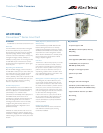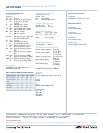
Datasheet | Media Converters
AT-CM2K0S
10/100/1000T to SFP media converter line card
Overview
The AT-CM2K0S Converteon blade is designed
to extend the distance of your network by
interconnecting LAN devices that are physically
separated by large distances.These bridging
converters have the functionality to connect any
managed/unmanaged 10Mbps, 100Mbps, or
1000Mbps (1Gbps) switch or hub using standard
10/100/1000T RJ-45 connections and convert
the electrical signal to Gigabit fiber optical signal
via its SFP port.
Expanding the Bandwidth
Each AT-CM2K0S bridging converter features a
10/100/1000T twisted pair port and an SFP port.
The twisted pair port has an RJ-45 connector
and a maximum operating distance of 100
meters (328 feet).These units can operate at half
and full-duplex.The
AT-CM2K0S fiber optic port
has a SFP slot and the maximum operating
distance is dependent on the SFP.
Flexible Deployment
The
A
T
-CM2K0S line card can be installed in the
complete r
ange of Converteon chassis’, allowing
them to be deployed in a standalone fashion
(A
T
-CV1000),
or in a m
ulti-slot chassis
(A
T
-CV1203 or AT-CV5000).When deployed in a
AT-CV5000 chassis, the line cards can be
unmanaged,
or managed with the inclusion of at
least one management card in the chassis.
In
unmanaged mode, the line cards can be easily
conf
igured using DIP switches,
where as in a
managed chassis,
all the configuration can be
performed remotely.
Whatev
er the chassis, the line cards can be hot
swapped providing the network manager with a
mechanism to simpl
y perf
or
m mo
ves/adds/changes
without having to power down other parts of the
network.
OAM (Operation,Administration and
Maintenance)
The AT-CM2K0S supports IEEE 802.3ah OAM
features, allowing the device to be remotely
configured and maintained in-band from a locally
administered AT-CMK20S.The local blade, used in
conjunction with a CPM management module,
allows network administrators to remotely setup,
test, and observe the remote devices without
having to dispatch engineers.
Link Test
The link test is a fast and easy way for you to test
the connections between the media converter
ports and the end-nodes that are connected to
the ports. If a network problem occurs, you can
perform a link test to determine which port is
experiencing a problem, and so be able to focus
your troubleshooting efforts on the cable or end-
node where the problem resides.
MissingLink
TM
and Smart MissingLink
TM
(SML)
The MissingLink (ML) f
eature allows the ports
on the media converter blade to pass the ‘Link’
status of their connections to each other
.
When
the media converter detects a problem with one
of the ports, such as the loss of connection to a
node, it shuts down the connection to the other
port, thus notifying the node that the connection
has been lost. Smart MissingLink (SML)
is when a link is lost on a port, the Link LED of
the port which still has a valid connection to its
end node starts to blink.These features allow
network administrators to quickly troubleshoot
network problems.
Hassle Free Support
All
Allied
T
elesis Ether
net media con
verter line
cards off
er free technical support, ensuring
trouble-free installation.
Key Features
• Tri-speed copper to SFP
• IEEE 802.3ah remote loopback, discovery,
MIB polling
• Auto MDI/MDI-X
• Auto-negotiation (IEEE 802.3u-compliant)
• 10/100/1000T port transparent to
IEEE 802.1Q VLAN packets
• Managed or unmanaged operation
• System and port LEDs
• SNMP
• MissingLink and Smart MissingLink
• Standalone (in AT-CV1000 chassis) or use in
multiples (AT-CV1203 or AT-CV5000 chassis)
• Supports SFPs for distances up to 80km
• Rate limiting
•
Dying gasp
AT-CM2K0S
Converteon
TM
Series Line Card
Allied T
elesis
www
.alliedtelesis.com




